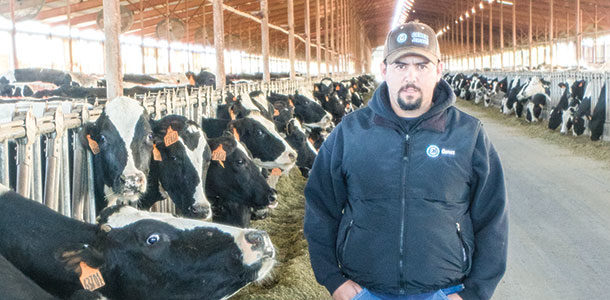Herd manager Martin Gomez oversees the reproduction program for Aardema Dairies’ 11,600 cows. Based in Wendell, Idaho, the dairy operates at five different sites, with a milking herd of 35 percent Jerseys and 65 percent Holsteins.
Gomez’s team of breeders service anywhere from 80 to 140 cows daily, breeding off of natural heats and reserving one day each week for OvSynch. Their 21-day pregnancy rate runs around 30 percent and their conception rate ranges from 43 to 44 percent for both cows and heifers. Those numbers are even more impressive given the frequent use of sexed semen.
He shares with Progressive Dairyman what it takes to successfully manage the operation’s reproduction program.
1. Dedicated team “Our breeders have to be dedicated to their work and really like what they do,” Gomez says. His team of four breeders have all been with the dairy for three years or longer. He motivates his team by setting and communicating goals; for example, one of those goals is to confirm 250 pregnancies each week.
2. Training and feedback Gomez sees great benefits in continual training for his team. Once each month, a representative from Genex comes out to the dairy to observe each of the breeder’s routines. They then review the numbers and receive feedback related to the herd’s reproductive goals.
For Gomez, feedback works both ways. He feels it is important to both provide it and receive it. “It’s all about talk,” he says, noting that he talks to each of his breeders daily. “I want to feel like they are engaging with me and the company. When they ask a question, I thank them for asking.”
3. Consistent protocols Gomez believes that getting in the pens with his team members as they do their jobs helps to ensure protocols are followed. This has helped him to build a level of trust in his employees. “Seeing things through their eyes really helps,” he adds.
One protocol Gomez adamantly enforces is maintaining no more than 95 percent stocking density in the breeding pens. “We count our pens daily,” he says. “I don’t like to have any breeding pens overcrowded.”
He also demands that employees treat the cows with “TLC.” He says, “Tender, loving care – that’s the biggest thing we do.” He does not tolerate mistreatment, adding, “I make sure all of my guys respect cows the way they should.”
4. Excellent transition cow care Good reproductive performance cannot be achieved with unhealthy cows, which is why Gomez is grateful for the dairy’s attention to dry, close-up and fresh cows.
Gomez credits the herd’s fresh cow manager with maintaining a high level of health among cows eligible for breeding, saying, “He never moves a sick cow to a breeding pen, which keeps the cows in those pens in really good, healthy condition.”
5. Communication Daily face-to-face conversations can’t be beat in Gomez’s book, but he must also rely on phone calls to correspond with the dairy’s multiple sites. While some goals and numbers are posted daily, he and his team gather together for dinner on a quarterly basis to dig deeper into the dairy’s records.
“I am happy with our reproduction on the dairy, and I communicate that to keep my employees engaged,” he says. “Without these things, I cannot do my job.” PD

Peggy Coffeen
Editor
Progressive Dairyman







